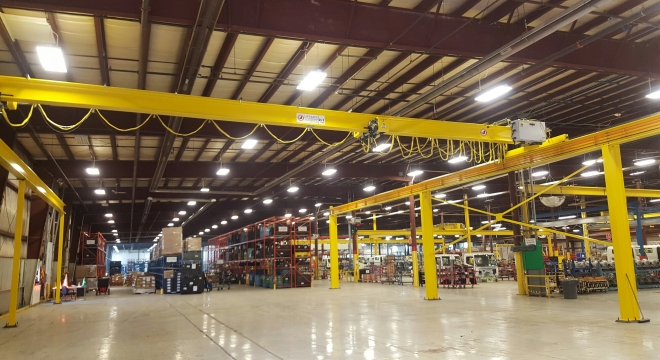Related: Overhead Cranes, How to Extend the Life of Your Crane and Hoists
It can be an extremely difficult task to operate a crane with the precision needed to ensure loads are picked up and dropped off without causing any damage to the environment or people around it. For the operator, it may even be difficult to see the item in question or to be able to know where the hook is relative to where the load is. That is why having a well-developed signaller and crane operator relationship is so important.
Though oftentimes crane and hoist hand signals are universal, sometimes how they come across can differ with each person and it is important that the crane operator both understands what the signaller is trying to convey but that they also trust them in what they are saying. Trust between these two individuals is imperative in ensuring that loads are lifting and dropped off efficiently and effectively. Often times a signaller is required by law if the operator’s view of an intended path of travel is obstructed in any way.
Who Can Be a Signaller?
Crane signallers are qualified individuals who are trained to give crane signals to the crane operator. There should only be one signaller at a given time, and if two signallers are changing between each other, the one who is in charge needs to have some form of identification, such as a badge. Also, a crane operator should only move loads with signals from one signaller. Though it is important to note that a crane operator must obey STOP signals no matter who gives it.
Signallers need to always be in clear view of the crane operator, in addition to being able to have a clear view of the load and the equipment. They should also be able to keep people outside of the crane’s operating area – so having an authoritative voice is key. Also, they need to ensure that they NEVER direct a load over a person.
Also, the crane signaller should understand the operations and limitations of the machine that they are signalling, this includes understanding how this particular crane swings, raises and lowers loads, how it stops loads and the boom deflection. This knowledge will not only help to ensure the signaller is giving proper and relevant signals, but can also help build trust between crane operator and signaller, as the operator will not have to second guess every signal given to them.
While oftentimes a radio and other electronic communications with an operator are available and may be used, also using hand signals is important to ensure that communication can continue seamlessly if something were to happen to the communications device.
Mobile Crane Signals
Overhead Crane Signals
Benefits of Using Hand Signals
Some of the most valuable benefits of hand signals include clarity, speed, distance and noise. With the use of hand signals, the chances of miscommunication decrease significantly and having visual signals are immediate and a skilled signaller often develops the ability to signal faster then a person can speak. Also often times there can be a delay in communications when using a radio system, where hand signals are often instantaneous and cranes often are in operation in highly noisy areas, which cause employees to wear earplugs, as hand signals require no noise the signaller and crane operator can communicate without needing to remove their safety equipment.
Having a highly developed and trusting crane operator and signaller relationship is imperative to not only ensuring loads are safely moved throughout your facility, but also to ensure the safety of people near the crane. Ensure that your crane signallers are following proper guidelines and are kept up to date on your cranes and how they move to be able to give correct hand signals, and ensure that your crane operators can trust the signals given to them. If the relationship between these two individuals deteriorates ensure that steps are taken to resolve the issue, or else mistakes may be made.
Sources:
http://www.ccohs.ca/oshanswers/safety_haz/Materials_handling/signals.html
http://www.craneserviceinc.com/rigging-signal-person-training/crane-operator-hand-signals-guide


